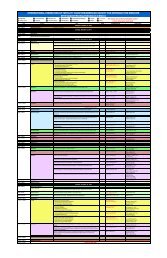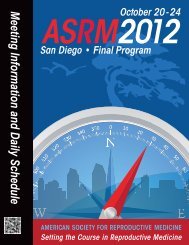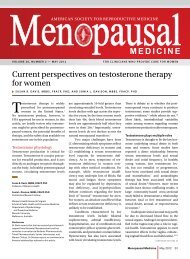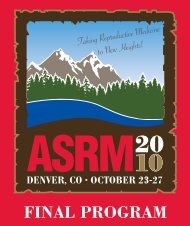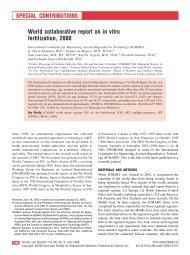scientific program • symposia - American Society for Reproductive ...
scientific program • symposia - American Society for Reproductive ...
scientific program • symposia - American Society for Reproductive ...
Create successful ePaper yourself
Turn your PDF publications into a flip-book with our unique Google optimized e-Paper software.
SCIENTIFIC PROGRAM <strong>•</strong> INTERACTIVE SESSIONS<br />
Tuesday, October 18, 2011 1:15 pm – 2:15 pm<br />
Interactive Session<br />
NEONATAL EXPOSURES TO REPRODUCTIVE TOXICANTS AND<br />
ADVERSE REPRODUCTIVE OUTCOMES<br />
Presented by the Environment and Reproduction Special Interest Group<br />
Susan H. Benoff, Ph.D. (Chair)<br />
The Feinstein Institute <strong>for</strong> Medical Research<br />
Kevin G. Osteen, Ph.D.<br />
Vanderbilt University School of Medicine<br />
Needs Assessment and Description<br />
While the effects of in utero exposure to endocrinedisrupting<br />
chemicals have been well studied in numerous<br />
mammalian species and the adverse adult reproductive<br />
outcomes of such exposures have been identified, only<br />
fragmentary human data exist supporting a relationship<br />
between neonatal exposures to environmental chemical<br />
contaminants and adult reproductive problems (e.g.,<br />
polycystic ovary syndrome (PCOS), premature birth,<br />
Leydig cell dysfunction). Nonetheless, recent evidence <strong>for</strong><br />
causality has been obtained from animal studies, which<br />
also help to identify the underlying mechanisms and<br />
transgenerational effects (e.g., altered estrogen signaling,<br />
epigenetic modification of gene expression). Animal studies<br />
also indicate that neonatal exposures can exacerbate<br />
the effects of in utero and adult exposures (e.g., prostate<br />
cancer). Recent studies provide preliminary evidence that<br />
nutritional intervention and anti-inflammatory therapies may<br />
be effective in countering the effects of neonatal exposures<br />
and provide a starting basis <strong>for</strong> patient counseling. Given<br />
the potential human benefit, there remains a need <strong>for</strong><br />
targeted research both in terms of markers <strong>for</strong> exposure<br />
and <strong>for</strong> identification of additional interventional therapies.<br />
Changes in public policy to minimize toxicant exposures<br />
would likely also prove beneficial.<br />
Room 224 G/H<br />
91<br />
Learning Objectives<br />
At the conclusion of this session, participants should be able<br />
to:<br />
1. Evaluate existing human data on the adverse effects of<br />
neonatal exposure to reproductive toxicants.<br />
2. Demonstrate the utility of animal models in the<br />
identification of underlying mechanisms of action.<br />
3. Summarize existing animal and human data in order to<br />
develop a rational basis <strong>for</strong> patient counseling.<br />
4. Assess the potential benefits of existing interventional<br />
strategies <strong>for</strong> improving reproductive outcomes.<br />
ACGME COMPETENCY<br />
Medical Knowledge<br />
Patient Care<br />
TEST QUESTION:<br />
After participating in this session, at a preconception<br />
counseling session in my practice, I will do the following:<br />
A. Not consider a workup of the male partner necessary if<br />
he had previously fathered a child.<br />
B. Generally not consider the occupational history of a<br />
couple’s parents and grandparents as being relevant to<br />
the potential <strong>for</strong> infertility or adverse pregnancy<br />
outcome.<br />
C. In addition to prenatal vitamins, recommend to the<br />
couple considering pregnancy that they each consider<br />
dietary changes prior to conception in order to reduce<br />
the potential impact of environmental toxicants on the<br />
health of their future children.<br />
D. Recommend that the female partner receive genetic<br />
counseling if she has concerns regarding her<br />
occupational exposures prior to conception.<br />
E. Not applicable to my area of practice.




